
When it was announced last month that the Mars Odyssey satellite had found water ice beneath the planet`s frozen carbon dioxide south polar ice cap, “I felt excited!” says Dr Lidija Siller, a physicist from the University of Newcastle. “I believe that the data I have explains how this water got trapped underneath the surface”. Dr Siller will be presenting the results of her research – which involves studying photochemical reactions in ice – at the Condensed Matter physics conference on Monday 8 April

Physicists at Glasgow University are using the world`s most powerful laser beam as an atom smasher to simulate conditions inside the Sun and to produce radioisotopes vital in medicine. Professor Ken Ledingham from the Department of Physics at Glasgow and his colleagues from Imperial College and the Rutherford Appleton Laboratory (RAL) are using the world`s most intense laser beam, produced by the VULCAN laser at the RAL near Oxford, to initiate nuclear reactions for a variety of exciting application

Chalmers researchers in Sweden, in an EU project involving colleagues from France, Holland, Germany, Italy and Finland, have shown that outdata from superconductor quantum computers can be read directly, even though the signal consists only of the presence or absence of two electrons, a so-called Cooper pair.
How far away are we from a functional quantum computer? Research results on quantum computers are beginning to appear. Göran Johansson at the Department of Microelectronics and Nanosci

A tiny measurement system that incorporates a lens as thick as two human hairs has been developed by researchers to investigate the force exerted on the wall of an artery as blood whooshes past. In a research paper published today in the Institute of Physics publication Journal of Micromechanics and Microengineering, Dr Rob Keynton and colleagues at the University of Louisville, Kentucky and Michigan Technological University, USA describe how they have designed and made an integrated miniature acous

A computational trick that stops imaginary knots collapsing could help us understand how to unravel a loop of DNA or reveal the true nature of elementary particles, research published today suggests.
In the New Journal of Physics, published jointly by the Institute of Physics and the German Physical Society, Phoebe Hoidn and Andrzej Stasiak of the University of Lausanne, Switzerland, and Robert Kusner of the University of Massachusetts, USA, explore the mathematical complexities of particula

Technological advances take place all the time – driven by need. But can these advances be speeded up in quantum leaps? The European Space Agency thinks they can, and is launching a pioneering project to test this.
The European Space Agency has launched a project to test whether technological advances can be speeded up in quantum leaps. The Star Tiger project will gather together a small team of enthusiastic scientists and engineers with a range of expertise from around Europe, put them toge
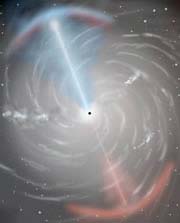
Astronomers shoot first film of the stars, dust and gas at the centre of a galaxy.
Astronomers have made their first movie of the roiling mass of stars, dust and gas at the centre of a galaxy.
The movie zooms into the disk of saucer-shaped galaxy NGC 1068 and through its super-bright core. It reveals an energetic region of space created by material flying out of the suspected black hole at the centre and crashing back into the disk. This region appears as a pale blue cloud

The planet Jupiter has spectacular rings of auroras around each pole but until now scientists have not been able to explain how they form. All auroras are caused by energetic charged particles crashing into the top of the atmosphere and making it glow. In the Earth’s auroras, these particles come from the Sun in a flow of charged particles known as the solar wind. But this can’t account for Jupiter’s auroras because the solar wind does not reach to the region where the brightest are found. Space phys
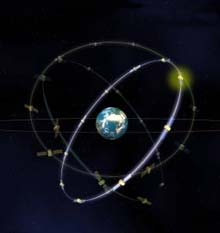
The European Space Agency warmly welcomes the decision taken today by the European Union Transport Ministers, meeting in Brussels.
Galileo has now been given the official go-ahead but for ESA that simply means that work on Galileo can continue! ESA teams have already been working for a number of years on satellite navigation systems, including the development of critical technologies such as atomic clocks and signal generators.
Developed by ESA in collaboration with the European U

Astronomers Dr Simon Jeffery of the Armagh Observatory and Dr Hideyuki Saio of Tohoku University, Japan, have finally solved a long-standing mystery concerning the creation of two particular kinds of rare stars. They have found that a class of variable stars named after their prototype R Coronae Borealis (RCrB), and a related group called `extreme helium stars` are the products of mergers between pairs of white dwarf stars. What kind of star results from the merger depends on the composition of the w
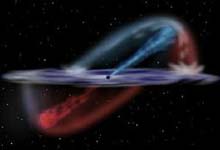
Astronomers using the Gemini North Telescope on Hawaii’s Mauna Kea report that they have created a three-dimensional movie of a powerful, active galaxy located some 70 million light years away. The addition of a new instrument, the Integral Field Unit (IFU), to the Gemini telescope enabled the group to study light from the galaxy NGC1068 in much greater detail. From a single still of NGC1068, the IFU generated data on the physical conditions and velocities of galactic material throughout the image.

Martian atmosphere churns harder in south making north wetter.
Scientists have figured out why it’s wet up north – on Mars. A new computer simulation of the martian atmosphere suggests that the planet’s geography causes differences in atmospheric circulation within the northern and southern hemispheres. These differences dump more water on the martian north pole, where it adds to the seasonal ice-cap.
Mark Richardson of the California Institute of Technology in Pasa

Astronomers at the Gemini telescope in Hawaii have obtained a complete, multi-dimensional picture, of the dynamic flow of gas and stars at the core of an active galaxy [NGC 1068] located 70 million light years away. The image was achieved in a single snapshot and is the first time such a picture has been obtained by one of the new generation of giant telescopes with an 8 – 10 metre light collecting mirror. The astronomers used a new instrument – the Integral Field Unit (IFU), designed and built at Du

The European Space Agency (ESA) and the Canadian Space Agency (CSA) have announced a call to communication companies who are interested in undertaking a contract for brand communication services related to the International Space Station (ISS).
The contract is a significant move for ESA and CSA who want to heighten the profile of the ISS within Europe and Canada to help meet the commercial objectives of the Space Station.
The two organisations want to hear expressions of interest
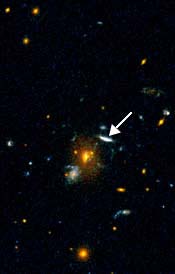
Light bending reveals clumps of matter around early galaxy.
European astronomers have got their first glimpse of the soup of matter that surrounded a galaxy in the early Universe, just 3 billion years after the Big Bang. Their results provide clues as to how this matter got together, which is crucial to understanding why the Universe looks the way it does today 1 .
The 12-billion-year-old galaxy is called MS 1512-cB58. It is not the earliest galaxy known, but
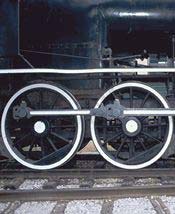
Spot-welds stick sliding metals
Two smooth, cold, metal surfaces are like pieces of tacky Sellotape. They form tiny spot welds that have to be broken apart before they can slide over each other. This, claim two physicists in California 1 , is another reason why metals stick as they slip if they are pressed together and pushed.
Such microscopic causes of friction and wear are increasingly important as the scale of mechanical engineering shrinks to below what